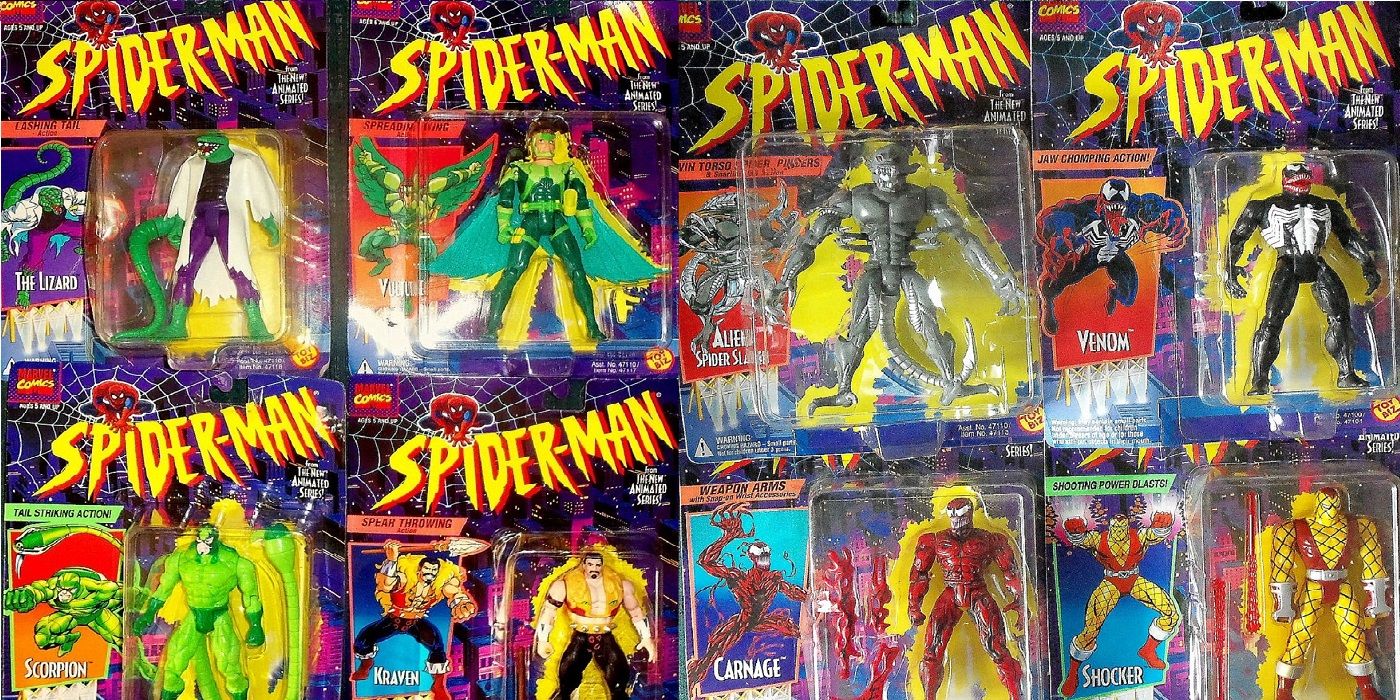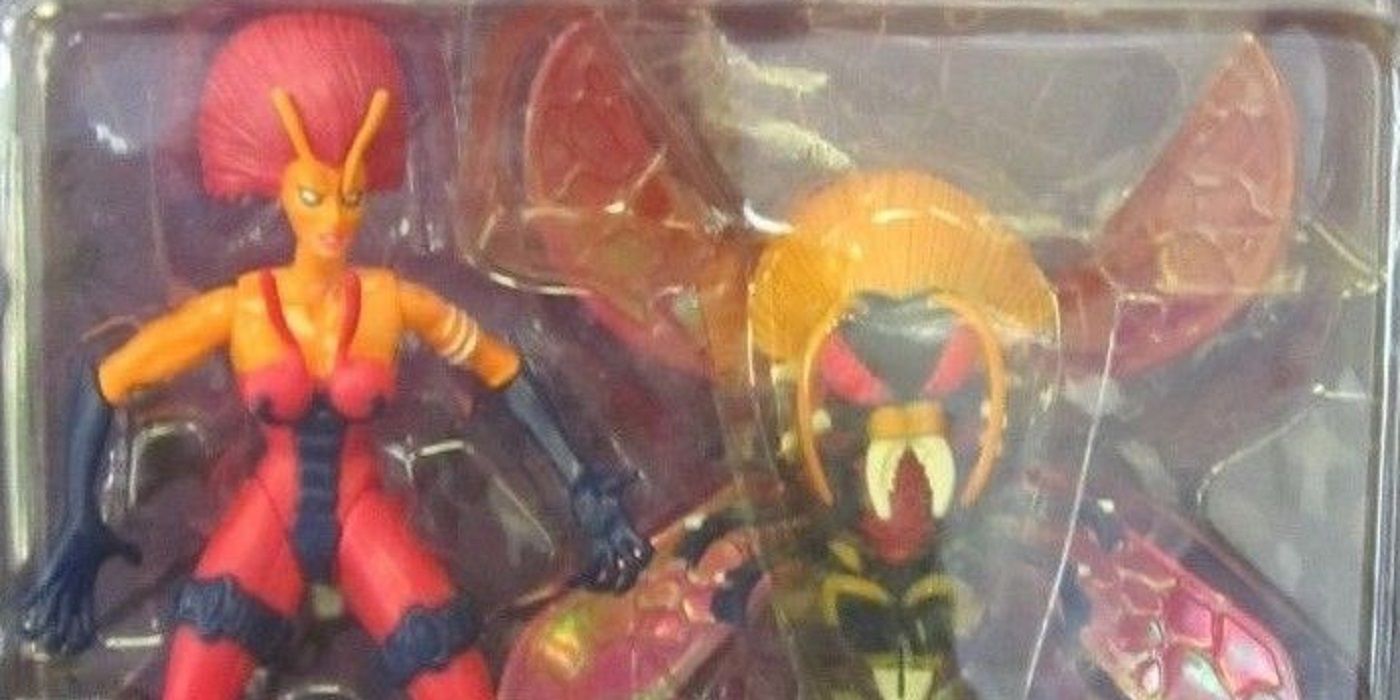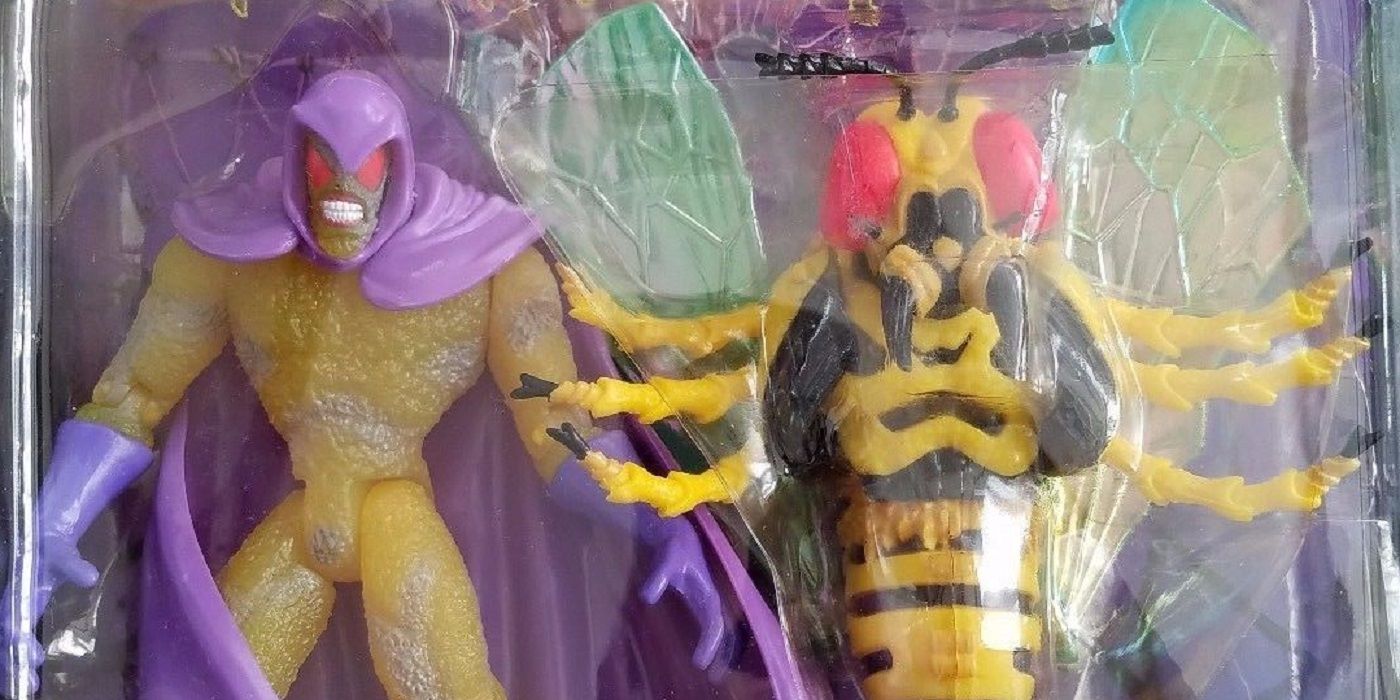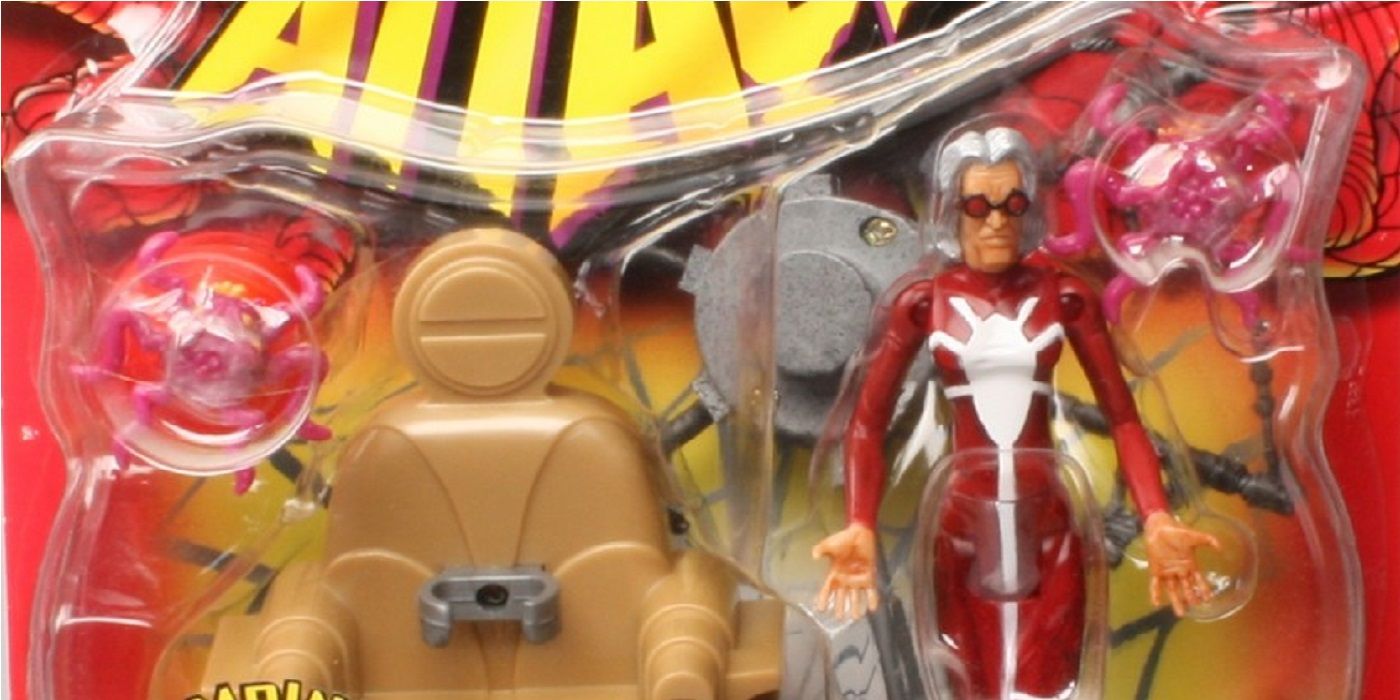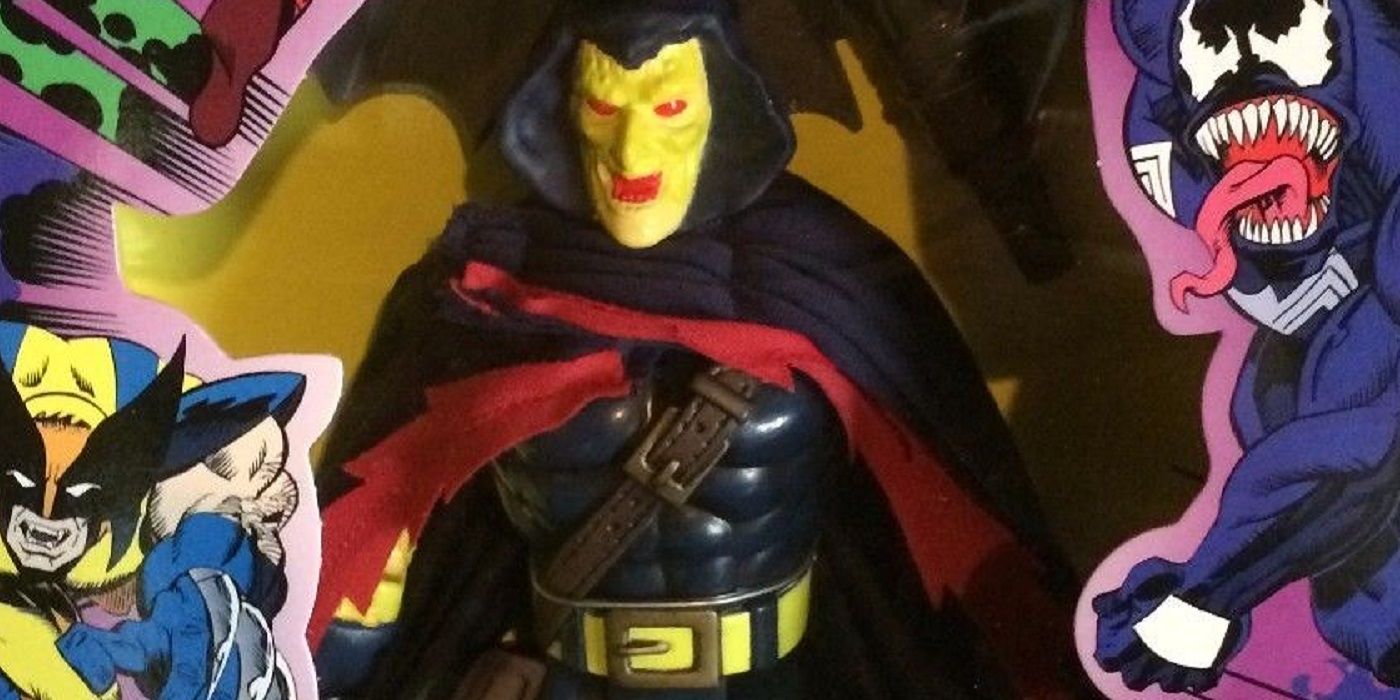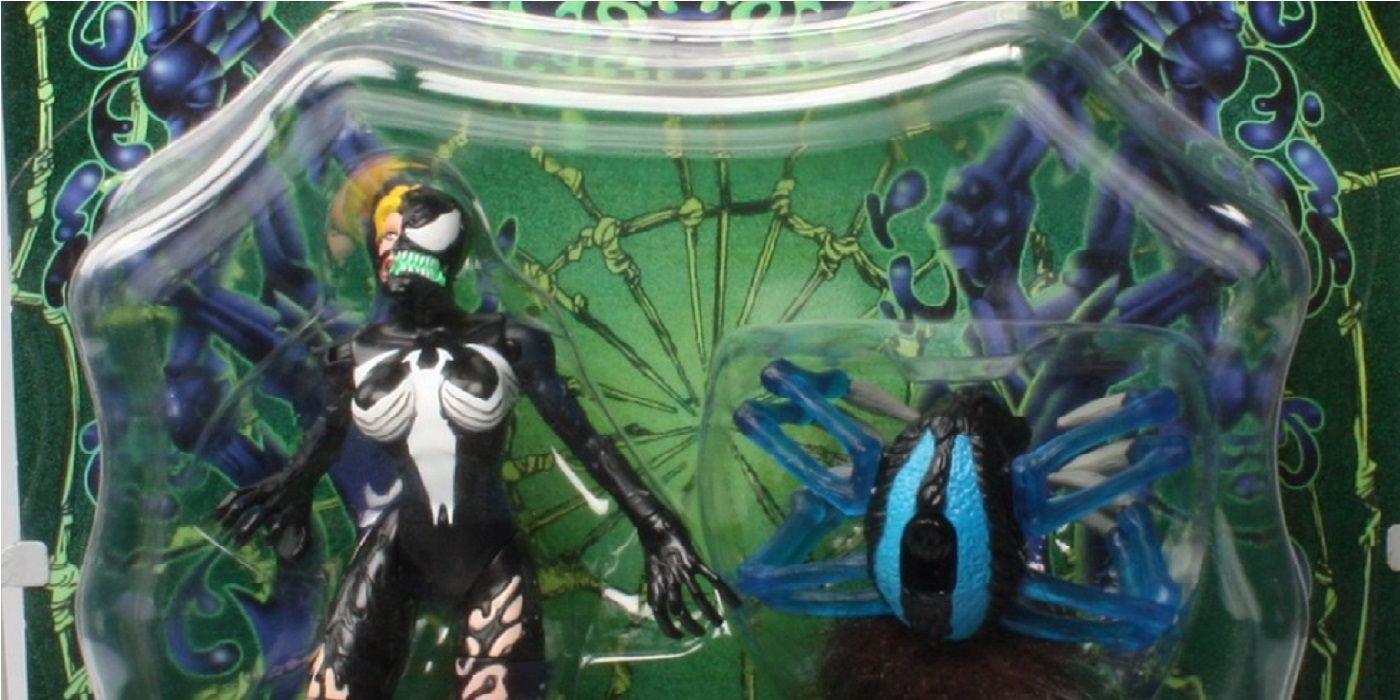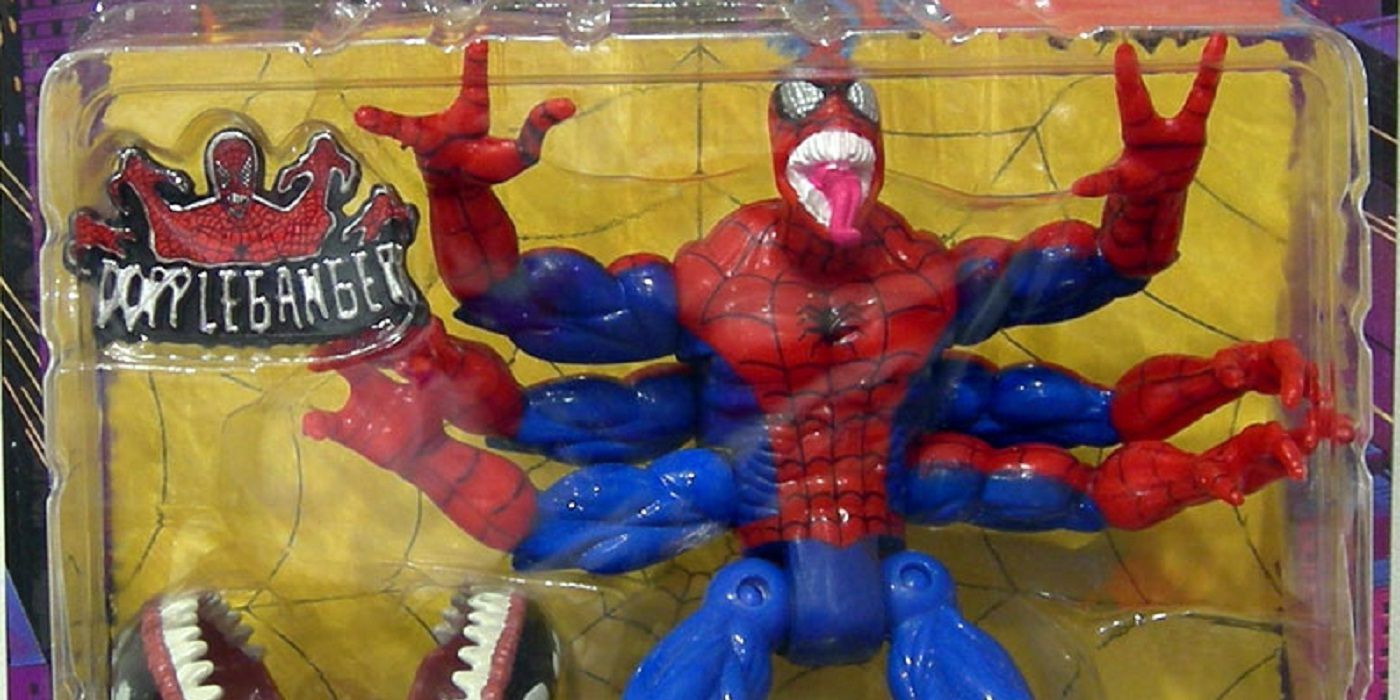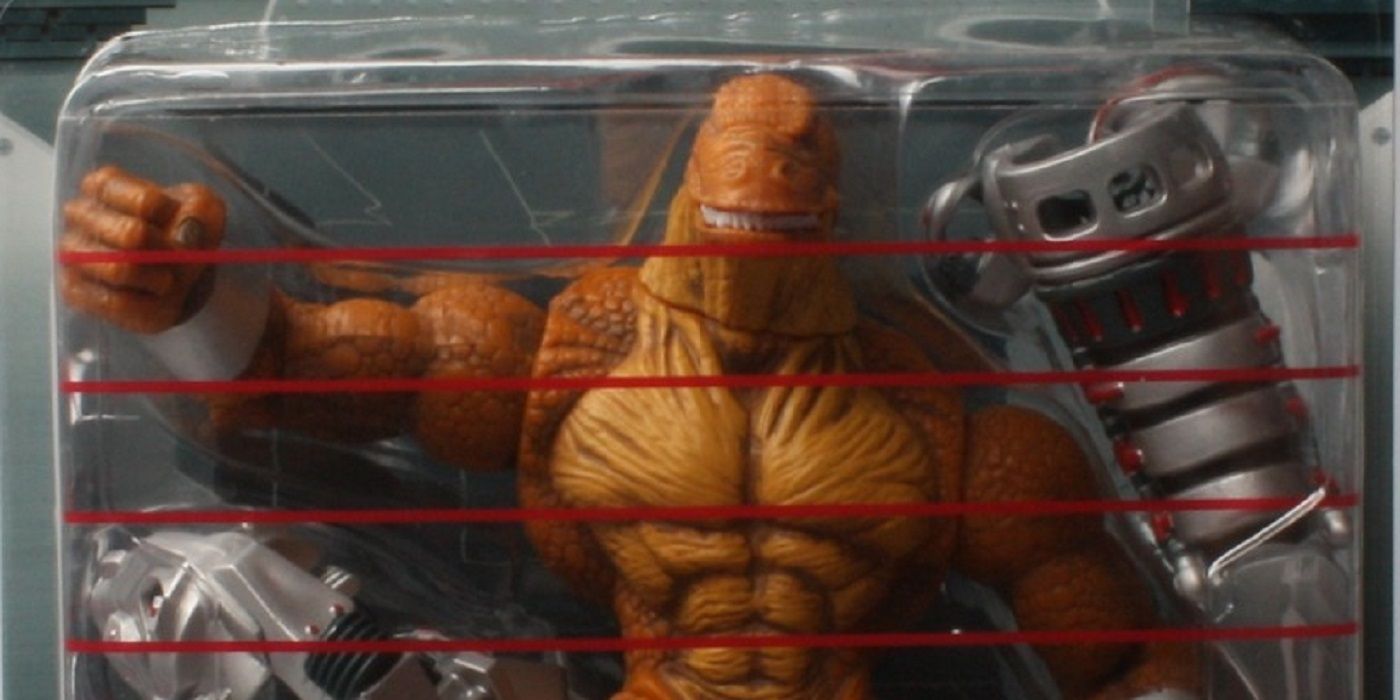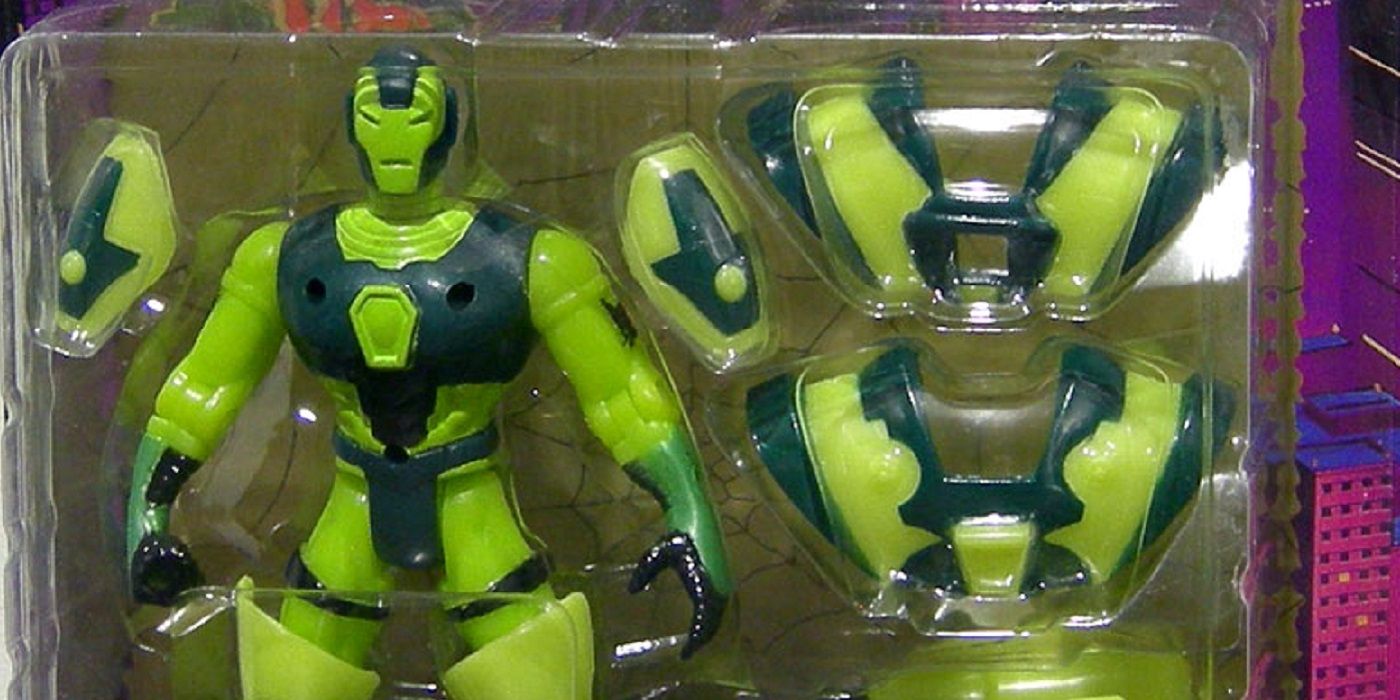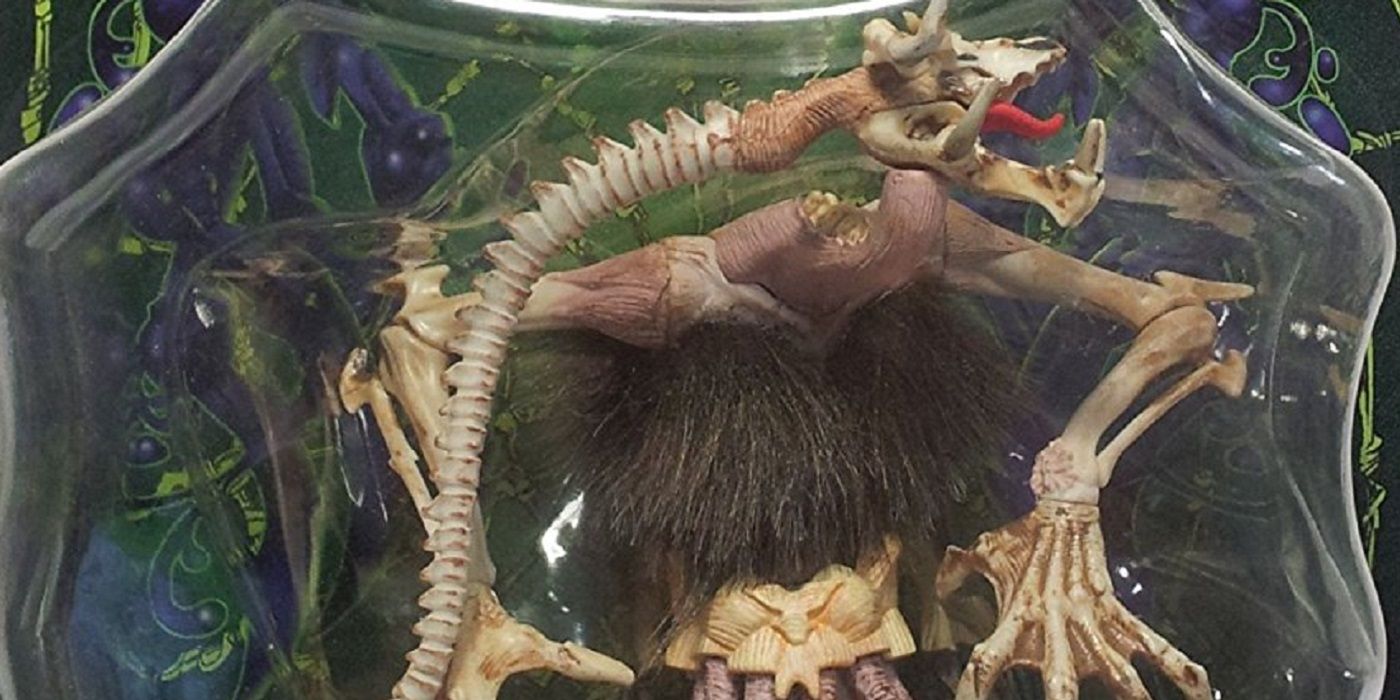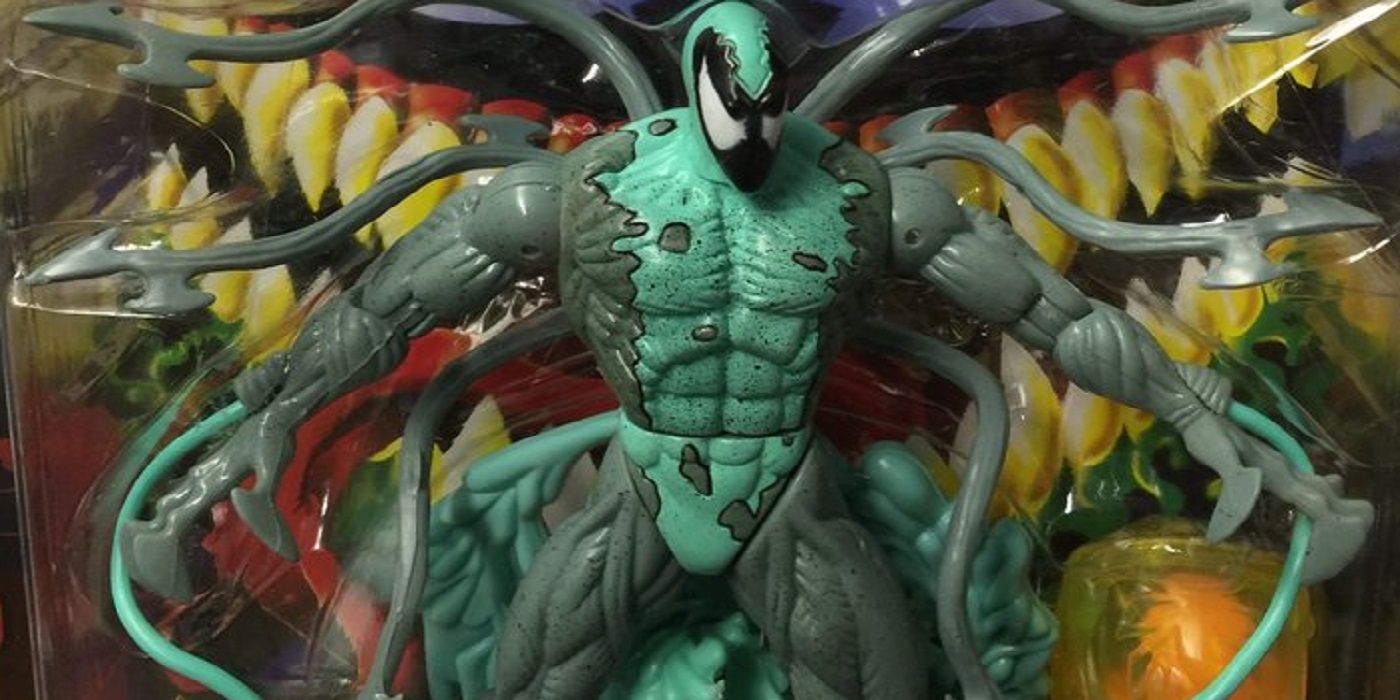A new age of Marvel action figures began in 1990 when ToyBiz acquired the license to produce action figures of Marvel Comics characters. These figures became so popular that by the end of the decade, when Marvel was going through bankruptcy proceedings, ToyBiz was able to acquire Marvel itself! While there were a number of standard "Marvel" toys, there were also two very popular individual toy lines: X-Men and Spider-Man. In the Spider-Man line, there were two subsets, one of which was based on the popular "Spider-Man: The Animated Series" cartoon.
RELATED: The Most Obscure X-Men Action Figures Of The 1990s
As compared to the X-Men line of toys, Spider-Man's had less obscure toys for one major reason. They mostly just made toys featuring Spider-Man and his two most popular villains, Venom and Carnage. There were so, so many different variants of Spider-Man, Venom and Carnage (and to a lesser extent, his other major villains like Doctor Octopus, Hobgoblin and Rhino). However, that didn't mean that there wasn't room for some obscure characters, as well. Here are the most obscure comic book characters to get a Spider-Man action figure during the 1990s.
15 WASP
This one was tricky. Originally, we went with the Beetle for this spot, who was really not all that much of a Spider-Man villain outside of his one memorable appearance in the miniseries "The Deadly Foes of Spider-Man" (where he committed a murder that would come to haunt him years later when he attempted to reform and become a member of the heroic Thunderbolts under his new name, Mach-V). Ultimately, though, we went with a much more famous character, the Wasp. So, why is such a famous character on a list of obscure characters?
First off, it's weird that she would be featured as a Spider-Man action figure. Moreover, this is not just the Wasp, but a very specific obscure version of the Wasp. During the "Avengers" crossover, "The Crossing," Marvel tried to revamp their seemingly "boring" Avengers characters by having popular artists redesign them. One of the new designs involved mutating the Wasp into a human-sized wasp-like creature. The change lasted for a year before she went back to her human form, but during that time, this weird stage in her comic book career was immortalized with an action figure!
14 TARANTULA
The Tarantula appeared to be an odd victim in a philosophical disagreement between creators over Spider-Man's capability as a fighter. When Gerry Conway introduced the Tarantula during the original "Clone Saga," he had the non-super-powered Tarantula handle Spider-Man very well, which went along with Conway's general viewpoint regarding Spider-Man, who he felt shouldn't be treated as a big bruiser. When Roger Stern then took over "Amazing Spider-Man" in the early 1980s, he wanted to re-establish Spider-Man's fighting credibility. That was shown by him easily defeating Tarantula. Stern went further and even killed Tarantula off.
When Conway returned to the Spider-books in the late 1980s, he promptly re-introduced a brand-new Tarantula soon into his run, and made this Tarantula more powerful, so he could tangle with Spider-Man more easily. This Tarantula was killed off, as well, in a "Venom" storyline. During a recent arc on "Amazing Spider-Man," Conway introduced yet another new Tarantula. Amusingly, the Tarantula action figure was part of a line where the figures would transform into mutated versions of themselves. Figures like these rarely have any basis in the actual comic book, but Tarantula was an exception, as he had been mutated into a giant tarantula before he died in the aforementioned Stern story arc.
13 SWARM
Swarm is one of the most outlandish superhero villains of all-time, as he was a former Nazi scientist who had escaped to South America where he became a beekeeper. A meteor landed near his bees and mutated them into super bees. He tried to investigate and take control of the super bees but they instead devoured him, leaving only a skeleton. However, in doing so they formed a strange telepathic connection to him, so now he could control the bees and use them to make the swarm his body. So yes, he is a Nazi with a body of bees. That's one heck of a supervillain idea!
He debuted fighting the short-lived superhero team known as the Champions, but soon became more of a Spider-Man villain in the years since. He does not appear that often, though. Since the bees that make up swarm are obviously the descendants of the original bees, that makes those bees mutants, which makes Swarm one of the most unlikely mutants around.
12 MADAME WEB
Madame Web is a bit of an odd fit for the list, as over the years she has ended up playing a notable role in a number of different Spider-Man comic books. A mutant who was a paraplegic confined to living in a special life support system that looked like a spider web (when your name is Webb, you just have to lean into it), Madame Web's power allowed her to see the future (her full name was Cassandra Webb, so again, Denny O'Neil was not subtle with her at all). She would join forces with Spider-Man to help her save people that she couldn't otherwise save due to being confined to a chair.
She ended up playing a particularly large role on the "Spider-Man" cartoon series, which is likely why she got a toy. However, it is still pretty strange to have an "action" figure whose powers don't really scream "action." Madame Web eventually passed her powers on to Julia Carpenter, the hero formerly known as Spider-Woman.
11 DEMOGOBLIN
During the 1980s, one of the most prominent Spider-Man villains was the mysterious Hobgoblin, a villain who had uncovered the secrets of Norman Osborn and his life as the Green Goblin and used Osborn's weaponry and formulas to become a major player in the New York world of crime. His secret identity was a closely guarded secret until it was finally revealed in a shocking twist that the current Hobgoblin was actually a replacement and that the original Hobgoblin was reporter Ned Leeds, who had been killed off a number of issues earlier in "Spider-Man vs. Wolverine." As it turned out, the reveal of his identity was the beginning of the end of the Hobgoblin as a major Spider-Man threat.
In an attempt to revive interest in the character, he cut a deal with a demon during the "Inferno" crossover and became an actual goblin! He eventually was able to break free from the demonic side of himself, but instead of being destroyed, it just became its own being, calling itself Demogoblin. Demogoblin remained a minor villain for a number of years before being killed off. The 1996 Demogoblin figure is technically from a general Marvel "Flying Heroes" line of figures.
10 BRIDE OF VENOM
A major factor in Marvel's attempt to transform Venom from an outright villain into a sort of anti-hero was the introduction of Eddie Brock's ex-wife, Anne Weying. In "Amazing Spider-Man" #375 (by David Michelinie, Mark Bagley and Randy Emberlin), during a battle with some mercenaries hired to capture Venom, a tower was knocked over and almost killed Anne. Spider-Man helped save her, which forced Venom to reevaluate his hatred of Spider-Man. They decided to form an uneasy truce, with Venom leaving New York and Spider-Man agreeing not to chase after him.
Soon after, though, Venom ended up in New York and Anne was attacked by a new Sin-Eater (the original was a serial killer who Eddie Brock thought that he had unmasked but turned out to be wrong, ruining his career as a journalist). Eddie forced the symbiote to bond with her to save her life. It turned her temporarily into a She-Venom, but it did save her life. However, it ended up traumatizing her so much that years later, when she saw Spider-Man swing by wearing his black costume, she killed herself. That re-started Venom's hatred of Spider-Man.
9 DOPPELGANGER
Doppelganger becoming an actual character is one of the weirdest results of a companywide crossover ever. You see, in 1992, Jim Starlin did a sequel to his popular "Infinity Gauntlet" crossover called "Infinity War," where Adam Warlock's "evil" side, the Magus, declared war on reality. He attacked the superheroes of the world with demonic duplicates of themselves that would assume their form and trick the other superheroes. In fact, a doppelganger of Reed Richards called all of the main superheroes to Fantastic Four headquarters and then set off a nuke -- luckily, Wolverine alerted everyone to the fake after defeating a doppelganger of himself, so Invisible Woman was able to stop the nuke.
When the crossover ended, almost all of the doppelgangers vanished, but not Spider-Man's. It just sort of hung around. Ultimately, it formed a strange partnership with the Demogoblin and they both became part of Carnage's warped Manson Family-esque team during "Maximum Carnage." The Doppelganger was seemingly killed by Carnage at the end of that crossover, but he was recently revived and is just hanging around somewhere.
8 SPOT
In the world of superheroes, way too many characters have real names that later play a role in their superhero or supervillain lives. We already mentioned Cassandra Webb. A famous villain example was the Flash villain, the Rainbow Raider, whose real name was somehow Roy G. Bivolo. In "Spectacular Spider-Man" #98 (by Al Milgrom, Herb Trimpe and Jim Mooney), we met a scientist working for the Kingpin. His name? Dr. Johnathon Ohnn. In that issue, Ohnn discovered the ability to teleport through a series of black hole-esque space warps that look like "spots." He then took on the villain name of the Spot. In other words, he became Johnny Ohnn... the Spot!
Okay, now that you've finished groaning over that pun, note that the Spot has actually made a number of appearances over the years, but almost always just to spotlight (no pun intended) how ridiculous of a villain he was. Technically, he was released as part of ToyBiz's Marvel Universe line, but he's clearly a Spider-Man villain, so we're counting him here.
7 STEGRON
Another great comic book name is Vincent Stegron, a S.H.I.E.L.D. scientist assigned to study DNA of dinosaurs from the Savage Land (can you imagine how amazing the Savage Land would be to scientists?). Stegron knew of Conners' past work with using lizard DNA to create the formula that turned him into the Lizard, so Stegron decided to do a similar thing with the dinosaur DNA that they were working with. SPOILER: it did, in fact, turn him into a half-man/half-Stegosaurus. He also gained the ability to mental control dinosaurs. He stole some from the Savage Land and then attacked New York City with them as Stegron the Dinosaur Man!
Stegron has been a very minor Spider-Man villain over the years, especially since, for his powers to really be of any true value, he has to travel all the way to the Savage Land, which isn't an easy trip. Stegron is the last of the figures on the list to not technically be from the Spider-Man line, as he was from a Marvel Universe release involving prisoners held in the Vault, the famed supervillain prison.
6 VAULT GUARDSMAN
Speaking of the Vault, the next character on the countdown is a nameless Guardsman from that supervillain prison. The Guardsman has a very strange history. Kevin O'Brien was a scientist working for Tony Stark who helped save Tony's life from an attack by the Espionage Elite. Tony befriended him and gave him a special new suit of armor in case of emergencies where Kevin would become the Guardsman. Sadly, Tony didn't know that there was a malfunction in the armor that caused the operator of the armor to be driven crazy with jealousy. So, Kevin became an enemy of Tony's and ultimately died in battle with Tony.
Later on, Kevin's brother Michael, a New York City police detective, decided to investigate his brother's death. He discovered the Guardsman armor, wore it and was also driven nuts by the armor. Luckily, this time Tony was able to fix the problem and he and Michael became friends. Michael used the armor as the head of security for Project: Pegasus, and later, Tony Stark mass-produced the Guardsman armor to work as standard attire by guards at the Vault.
5 HYBRID
Keeping with the Vault theme, Scott Washington was a Guardsman who befriended the superhero known as Justice when Justice was sent to prison briefly for killing his abusive father. Later, Washington discovered some symbiotes in the custody of the Vault. He realized that the symbiotes were not evil, so he freed them. He was fired and returned home to New York City. While there, he and his brother were shot by a gang. His brother was killed and Scott was paralyzed. The symbiotes eventually found him there and bonded with him, giving him the ability to walk again.
Going by the name Hybrid, Scott had to deal with having four different voices in his mind. Amusingly enough, unlike Venom and Eddie Brock, this time it was Scott who wanted to commit acts of violence against the gang that crippled him, while it was the symbiotes who tried to restrain him. Years later, Eddie Brock killed Washington when he was on a mission to eradicate all symbiotes on Earth. The Hybrid symbiotes were taken in by the military. Deadpool briefly bonded with the Hybrid symbiotes in a fight with Carnage.
4 SCREAM
In the very first "Venom" miniseries, "Venom: Lethal Protector" (by David Michelinie, Mark Bagley, Ron Lim and a bunch of inkers), Venom ran afoul of the mysterious Life Foundation, a group of survivalists who were preparing for a post-apocalyptic world. Part of their plan involved capturing Venom and forcing the Venom symbiote to create more offspring, a la Carnage. They ultimately succeeded in creating five new symbiotes. They merged these symbiotes with a group of mercenaries that they hired with the intent that these new beings would serve as police officers in the new post-Apocalyptic world.
Of course, that did not work out. One of the new creatures formed was Scream, who eventually murdered the other four symbiote/hosts when she had a mental breakdown and believed that all symbiotes were evil. She then reformed and decided to search the world for other, benevolent users of symbiotes. Tragically, she was also murdered by Eddie Brock when he ironically had the same idea she had years earlier, that all symbiotes needed to be eradicated.
3 PHAGE
Phage was also one of the five symbiotes created by the Life Foundation and then bonded to mercenaries working for the Foundation. However, the action figure for Phage is not actually for the symbiote by that name, but for another character entirely. Introduced in the miniseries, "Venom: The Hunted" (by Larry Hama and Duncan Rouleau), the Xenophage was an alien who was much like Venom, except that it came to Earth to kill symbiotes.
It was a metamorphic alien but it had the ability to render symbiotes (and their hosts) brainless. In effect, it would "eat" the brains of its victims (this was a reference to a claim made by an early talking Venom action figure from ToyBiz). In an attempt to get Venom's attention, it began killing people and making people think Venom was the killer. Scream actually ended up helping Venom defeat the Xenophage, although she was badly wounded in the battle. Venom ended up killing the Xenophage.
2 LASHER
After the Life Foundation forced Venom to spawn new symbiotes, the symbiotes were merged with various members of the Life Foundation mercenary squad. They all were appeared to have been destroyed at the end of the first "Venom: Lethal Protector" miniseries, but they soon popped up again. However, eventually four of the five symbiote/host beings, including Lasher, were killed by their "sister," Scream. The symbiotes survived, though, and soon formed Hybrid.
When Eddie Brock killed Hybrid, the symbiotes were taken by the military and then bonded with soldiers to help fight against Carnage. That worked the first time, but Carnage was better prepared the next time and launched a sneak attack on the soldiers and slaughtered them all. The symbiotes then bonded with a military dog and all but Lasher merged with Deadpool to help him fight Carnage. Deadpool then gave the other three symbiotes to Lasher (still bonded with the dog) to bring back to the government.
1 RIOT
The first "Venom: Lethal Protector" series also served to form a new supporting cast for Venom, as he began to live with the "underworld," the forgotten homeless people in San Francisco who ended up underground (which drew them into conflict with the Life Foundation, who were obsessed with building underground bomb shelters to help their membership after the apocalypse hit). It is interesting to compare these symbiotes to those "forgotten" people because interestingly enough, Phage, Riot, Lasher and Scream were never actually given names in the original "Venom" comics! They actually were given individual names for the first time when they were given toys in the 1996 "Venom: Planet of the Symbiotes" release of the Spider-Man line of toys!
The comics did not use those names until Scream was named in a "Civil War: Battle Report," and Lasher, Riot and Phage (plus the fourth symbiote, dubbed Agony) were named when they bonded with the soldiers in the "Carnage U.S.A." miniseries, before being killed in the follow-up, "Deadpool vs. Carnage." You don't get much more obscure than not having a name for almost 20 years!
Who was your favorite obscure Marvel character to get their own Spider-Man action figure? Let us know in the comments section!

